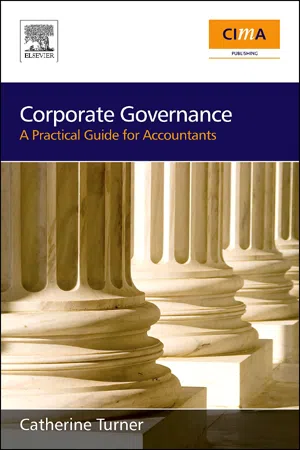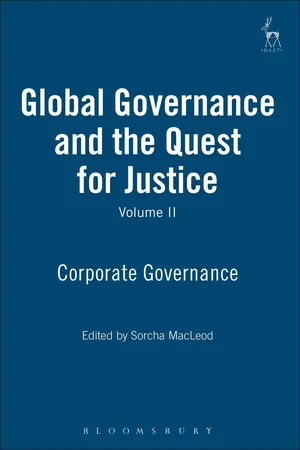Law
Corporate Governance law
Corporate Governance law refers to the system of rules, practices, and processes by which a company is directed and controlled. It encompasses the relationships among stakeholders and the goals for which the corporation is governed. The primary aim of corporate governance law is to ensure transparency, accountability, and fairness in the management and decision-making processes of a company.
Written by Perlego with AI-assistance
Related key terms
1 of 5
9 Key excerpts on "Corporate Governance law"
- Marc Moore(Author)
- 2013(Publication Date)
- Hart Publishing(Publisher)
Without it the most ordinary business could not be carried on, and the corporate powers could not be executed’. 47 People ex rel Manice v Powell 201 NY 194, 201 (1911) (Court of Appeals of New York) (Chase J). 48 Underlying this position is the traditional adherence of US courts to the so-called ‘con -cession’ theory of corporate law, whereby the (state-derived) act of incorporation, rather than (contractually-derived) act of initial business association, is regarded as the principal factor to which the legal existence of the corporation is attributable. On this generally, see WW Bratton, ‘The New Economic Theory of the Firm: Critical Perspectives from History’ (1989) 41 Stanford Law Review 1471; Parkinson, Corporate Power and Responsibility , above n 4, 25–32. 26 Defining Corporate Governance law (at individual State level) vest executive authority for the running of the business in the hands of a company’s board (as opposed to its share -holders), then the board’s constitutional discretion over executive affairs can be regarded as sovereign and absolute, subject only to compliance with minimal fiduciary standards of honesty, loyalty and decision-making rationality (what in US corporate law jurisprudence is known as ‘the busi -ness judgment rule’ 49 ). 50 Thus shareholders of Delaware corporations, inter alia, have no right to give any legally binding directions – whether specific or general – to the board regarding the running of the business, 51 or to acquire any broader constitutional authority over managerial affairs absent the assent thereto of the board itself. 52 More fundamentally, section 141 arguably establishes the 49 For an examination of this important legal doctrine from the perspective of the thesis in this book, see below ch 4 of this volume, pt IV. For a general critical rationalisation of the rule, see SM Bainbridge, ‘The Business Judgment Rule as Abstention Doctrine’ (2004) 57 Vanderbilt Law Review 83.- eBook - ePub
Corporate Governance
A practical guide for accountants
- Catherine Turner(Author)
- 2009(Publication Date)
- CIMA Publishing(Publisher)
Chapter 1. What is Corporate Governance?1.1. DefinitionThe term ‘Corporate Governance’ has no single formal definition, and is often therefore used in a variety of differing ways (along with that other serial victim of flabby usage – ‘Best Practice’). Generally speaking, however, the term is used to describe a range of issues relating to the ways in which companies may be directed and controlled. It is, broadly, the systems and processes for ensuring proper accountability, probity and openness in the conduct of an organization's business.In some circles the term is also used to encompass wider issues relating to:♦ the improvement of shareholders' performance; and ♦ other stakeholder arguments focused on addressing precisely whose interests a company, and its operators, ought properly to take into account.Stakeholders, of course, can include not only shareholders, but also customers, employees, retired employees (pensioners), suppliers, lenders and the wider community within which the company operates.1.2. Some key concepts encountered in the world of corporate governance1.2.1. Codes of governanceIn general, good corporate governance involves management judgement and is essentially voluntary in nature. However, there are a number of areas, as we shall see, where compliance is mandatory – either as a condition of continued membership of a particular body, or as a result of specific legislation. In Chapter 2 , we will look at some relevant codes, consider their origins, their status (mandatory or voluntary), and look at how some have been adapted for specific types of organization.1.2.2. Enlightened shareholder valueThis refers to a concept introduced under the Companies Act 2006. Section 172 of this act introduced the idea of ‘enlightened shareholder value’ into the duty to promote the success of the company for the members' benefit. It requires that a director act in the way which he believes, in good faith, to be most likely to promote the success of the company for the benefit of its members as a whole. In fulfilling this duty, he must have regard – inter alia – to:♦ The likely long-term consequences of any decision; ♦ The interests of the company's employees; ♦ The need to foster the company's business relationships with suppliers, customers and other parties; ♦ The impact of the company's operations on the community and the environment; - eBook - PDF
Corporate Social Responsibility of Multinational Corporations in Developing Countries
Perspectives on Anti-Corruption
- Adefolake O. Adeyeye(Author)
- 2012(Publication Date)
- Cambridge University Press(Publisher)
168 what is corporate governance? Primarily, corporate governance deals with the relationship between shareholders and directors in managing the affairs of the company. The UK Cadbury Report on the Financial Aspects of Corporate Governance refers to corporate governance as the system by which companies are directed and controlled. 3 The Cadbury definition has most successfully stood the test of time and is most widely adopted. 4 Generally, corporate governance focuses on the system of controlling and directing a corporation, particularly the structure and process of governance. The structure includes the make-up of boards, numbers of and types of non-executive directors, and board committees, while the process includes the provision of information, internal controls, financial reporting and terms of service agreements. 5 Corporate governance also addresses the core areas of board responsi- bility such as strategy, performance, conformance and accountability to shareholders. 6 The UK Corporate Governance Code consists of princi- ples and provisions aimed at guiding effective board practice. 7 The US Sarbanes-Oxley Act aims to protect investors by improving the accuracy and reliability of corporate disclosures. 8 These issues are all internal to the company, although they may have external consequences. If a company collapses, creditors may be affected, employees will lose jobs with dire consequences for their families and communities may feel the impact. Generally, corporate governance does not focus on ‘values’ or other behavioural matters which CSR is typically concerned with. However, the need to give attention to broader values is becoming an essential part of good governance, and the part values and other ‘softer’ issues should rightly play in the approach to good corporate governance is now being considered 9 in the governance literature. - eBook - PDF
Global Governance and the Quest for Justice - Volume II
Corporate Governance
- Sorcha MacLeod(Author)
- 2006(Publication Date)
- Hart Publishing(Publisher)
1 Corporate Governance and the Regulation of Business Behaviour JOHN PARKINSON INTRODUCTION T HE TERM ‘ CORPORATE governance’ has a range of meanings. For present purposes two stand out. The first refers to the various ways in which society attempts to control company behaviour in the pub-lic interest. 1 Here what is being ‘governed’ is the company itself, the most obvious modality being regulation by the state ‘external’ to the company, for example, the requirements of employment law, consumer law, or envi-ronmental law. The second meaning is the one more familiar to company lawyers, of ‘company-level’ governance: in the words of the Higgs review, the ‘architecture of accountability’ or ‘structures and processes’ that ensure that those responsible for managing companies do so in accordance with the legitimate objectives of the business. 2 Directors’ duties, boards that contain members with a ‘monitoring’ role, and disclosure of financial and other information are examples of mechanisms of governance so under-stood. While some would argue otherwise, 3 corporate governance in the second sense can be regarded as a sub-set of governance in the first. That is, company-level controls reflect at least in part a state determination of what corporate objectives should be and of corresponding accountability arrangements. In the Anglo-American corporate world the purpose of such controls is generally viewed as being to enforce a goal of shareholder wealth 1 See, eg A Demb and F-F Neubauer, The Co rporate Board: Confronting the Paradoxes (New York, Oxford University Press, 1992) 2-4; ND Lewis, Law and Governance (London, Cavendish, 2001) 172. 2 See D Higgs, Review of the Role and Effectiveness of Non-Executive Directors (London, DTI, 2003) 11. 3 Eg, exponents of the nexus of contracts theory of the company, who emphasise the ‘pri-vate’, contractual origins of governance arrangements. - eBook - PDF
- Bob Tricker(Author)
- 2021(Publication Date)
- Cambridge University Press(Publisher)
Deeper consideration of those two terms suggests that the concept of ‘corporate governance’ may cloak some major philosophical issues. In the fourth century BC, Aristotle laid down rules about how power and authority should be exercised over Greek city-states. Corporate governance concerns the way power is exercised over corporate entities. Every corporate entity is defined by its constitution or rules and governed by its members, under the law of the relevant jurisdiction. A ‘corporate entity’ is an organisation created under a written constitution or set of rules, which establish its identity, purpose, membership and governance processes. In the case of a limited liability company, the company is incorpor- ated under company law. Its constitution is provided by the company’ s memo- randum and articles of association filed on incorporation. Its members are the shareholders with voting rights, which typically allows them to nominate and elect the board of directors and matters that can be raised at shareholder 130 The exercise of power within corporate entities is the subject of management. 57 The Evolution of Corporate Governance meetings. The directors have the power and the duty to govern, in accordance with the company’ s articles. In a company listed on a stock exchange, the company must also conform to the listing rules of that exchange, and to relevant corporate governance codes. In a private company, the shareholders have the rights and the directors have the powers and duties granted by that company’ s articles; although, in a closely held family company, some family members may wield more influence than their voting rights suggest because of their position in the family. In a professional body, such as the UK Law Society or the Institute of Chartered Accountants, full members have the rights and the Council has the powers and duties granted by the organisation’ s charter. - eBook - PDF
Theory and Practice of Corporate Governance
An Integrated Approach
- Stephen Bloomfield(Author)
- 2013(Publication Date)
- Cambridge University Press(Publisher)
P A R T 2 THE RELATIONSHIP BETWEEN LAW AND GOVERNANCE C HA P T E R 4 The protection of the laws This chapter will look at the impact of the law on governance and considers: the background to the Companies Act 2006; the ways that the law impacts on governance; the concept, functions and purpose of the share; protecting the shareholder individually; protecting capital; protecting shareholders collectively; in meetings; protecting value and power; meetings and votes; remedies available to shareholders to protect their rights; the company. Introduction This chapter and the next will look at the legal framework inside which issues of governance mostly rest. The overall framework is considered in this chapter with more details of how law and governance interact in specific examples in Chapter 5 . The chapter also includes a development of the further classification of governance activity into procedural, behavioural and structural types and relates these to issues of law and regulation. Effective corporate governance is a compound of many things – administration, management, accounting and law all figure in the mixture. Separating them out and studying them individually unfortunately potentially isolates them from the necessary interaction they have with each other. But a familiarity with the mechanics of operational governance – the legal/administrative aspects – is essential in order to comprehend the way that governance actually works as an activity. This chapter concentrates on some of the necessary preliminaries involving how the law impacts on governance which can then be developed into showing how governance works in practice (on the foundation of a legally-prescribed administrative structure) and how it sometimes differs from descriptions based on theory. 81 - eBook - PDF
Corporate Governance
A Survey
- Thomas Clarke(Author)
- 2021(Publication Date)
- Cambridge University Press(Publisher)
a founding constitution; ii. a system of rights and duties; 13 Elements in Corporate Governance iii. mechanisms for accountability and transparency; iv. monitoring and performance measures; v. stakeholder rights; vi. good governance standards; vii. independent gatekeepers. Returning specifically to corporate governance, Cadbury reminds us of the ethical dimension of corporate values and activity: that firms exist not just for the profit of their immediate owners, but to fulfill a wider social responsibility. The boundaries of what constitutes corporate governance are greatly extended by Turnbull (2012) from the narrow Anglo-American focus on market-oriented publicly traded firms. He claims, ‘Corporate governance includes all types of firms whether or not they are formed under civil or common law, owned by the government, institutions, or individuals, privately or publicly traded’ (Turnbull 2012: 433). Agency theory is almost entirely concerned with listed companies with unitary boards operating in market systems. However, Turnbull illustrates how the great majority of companies in most economies are not listed on stock exchanges, have compound boards representing diverse shareholder and other stakeholder interests, and have an attenuated relationship to the market. Thus the traditional market-based theory of the firm ‘becomes less relevant when economic transactions are mediated by cultural priorities, business related associations, trade, vocational, family, social, and political networks’ (Turnbull 2012: 435). In this context, the finance model of the firm, in which the central problem of corporate governance is how to construct rules and incentives to align the behaviour of managers with the interests of owners, needs to be supplemented with other models of corporate control including the stewardship, stakeholder, and political models applying not simply financial analysis but a cultural and power analysis among other perspectives. - Michaela Rankin, Kimberly Ferlauto, Susan McGowan, Patricia Stanton(Authors)
- 2022(Publication Date)
- Wiley(Publisher)
• It arguably places a higher duty on directors to determine which corporate governance practices are required, rather than simply accepting a minimum set of practices as being adequate. • Its flexibility means that the corporate governance practices can be adapted for the particular circum- stances and environment of the entity. The key disadvantage of this approach is that it essentially leaves it to the directors to interpret these principles and decide which corporate governance practices are needed, so it relies on their honesty, integrity and commitment to good governance. If directors are competent and act in good faith, then this is not a problem, but many of the corporate abuses that have renewed the interest in corporate governance practices have stemmed from people not acting appropriately. Practical considerations In practice, corporate governance in most countries involves various combinations of both the rules- and principles‐based approaches with the following. • Specific legislation that requires certain corporate governance practices to be followed by law. The specific practices, plus the penalties and degree of enforcement vary from country to country. Common examples of legislated practices are: – requirements for audit committees and for accounts to be audited – shareholders’ rights to vote to remove directors – requirements to appoint independent directors to the board – legal penalties for directors’ breaches of duty. • Codes of corporate governance practice (based on principles) issued by government or industry groups and also by securities exchanges. These may suggest specific examples as best practice, although corporations are not required by law to follow them. Common examples are: – separation of the chair of the board of directors and the CEO; in most countries (e.g. Singapore) this is not legally required. – a remuneration committee; this may not be required by law (as is the case in Malaysia).- Ilias Bantekas, Michael Ashley Stein(Authors)
- 2021(Publication Date)
- Cambridge University Press(Publisher)
Cutting back on systems and processes 3 EM Dodd, ‘For Whom Are Corporate Managers Trustees?’(1932) 45 Harv L Rev 1145. 4 AA Berle, ‘Corporate Powers as Powers in Trust’ (1931) 44 Harv L Rev 1049. 5 The UK Companies Act 2006 has more than 1300 sections, the vast majority of which relate in one way or another to the rights of shareholders and the duties of directors. 6 In the UK Companies Act 2006, there are only brief mentions of other stakeholders in the company, notably s. 172. 7 See, for example, A Tooze, Crashed: How a Decade of Financial Crises Changed the World (Allen Lane 2018). 8 R Carson, Silent Spring (Penguin 1965) is perhaps the best known such analysis. 9 See, for example, M Adler, Economics for the Rest of Us (The New Press 2009). 10 See, for example, L Hakelberg, The Hypocritical Hegemon (Cornell University Press 2020). Corporate Governance and Corporate Social Responsibility 67 designed to protect workers, communities and the environment; paying low wages; engaging in aggressive tax avoidance arrangements – all of these reduce costs, increase profitability and thus maximise the amount that is available to distribute to shareholders. Company law is not, of course, the only relevant consideration in these respects. If the concern is the well-being of communities and the environ- ment, then perhaps environmental law, consumer protection law and tort law, for example, can provide reassurance. Similarly, if the concern is the position of workers, then employment law and occupational health and safety law can come to their assistance. Finally, if the worry is the non- payment of tax due, then the answer is surely the appropriate enforcement of revenue law. There is no gainsaying, however, that the very fact that this array of law and regulation is required could be read as an indication that there is something flawed at the heart of the corporation.
Index pages curate the most relevant extracts from our library of academic textbooks. They’ve been created using an in-house natural language model (NLM), each adding context and meaning to key research topics.








